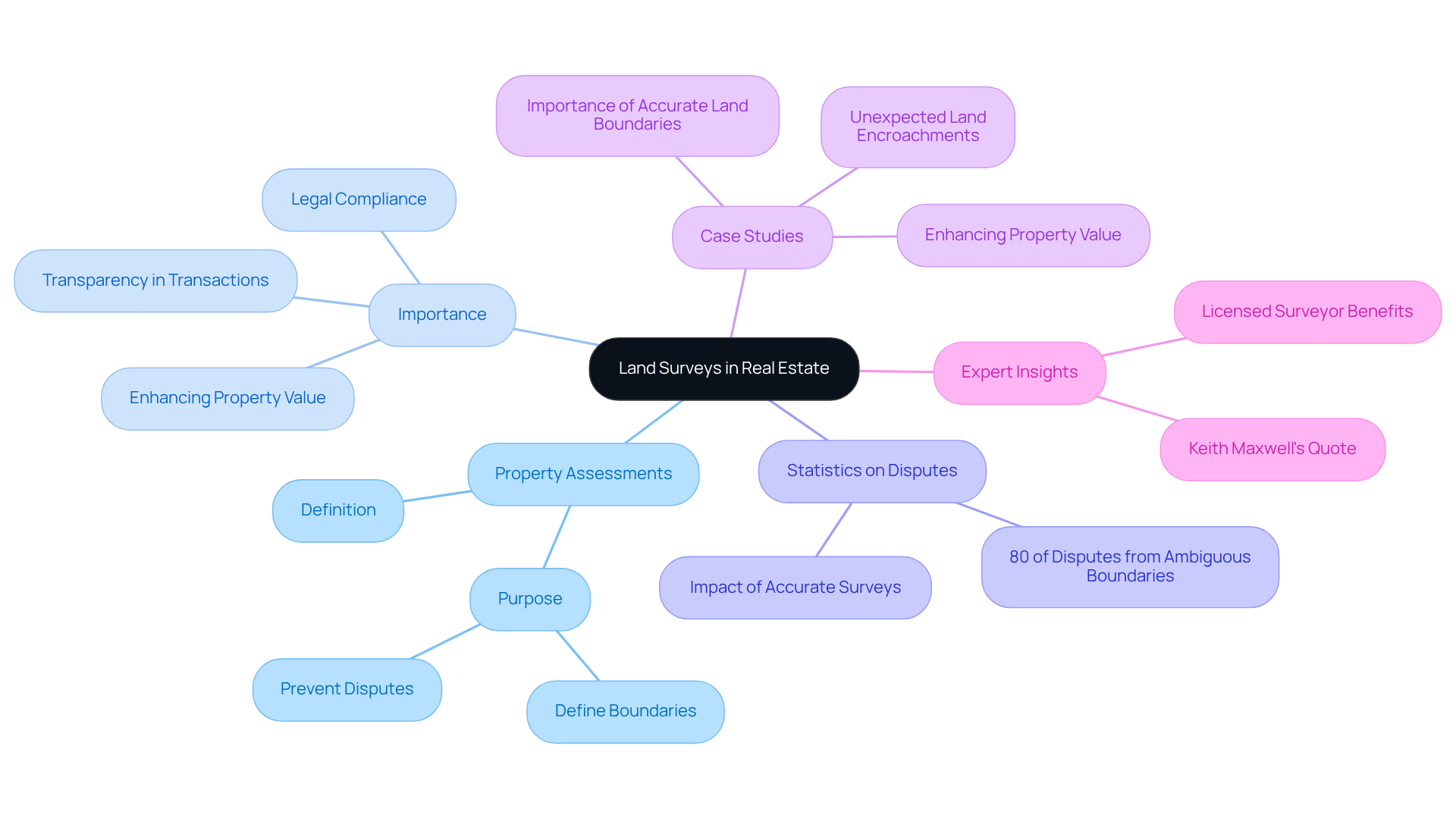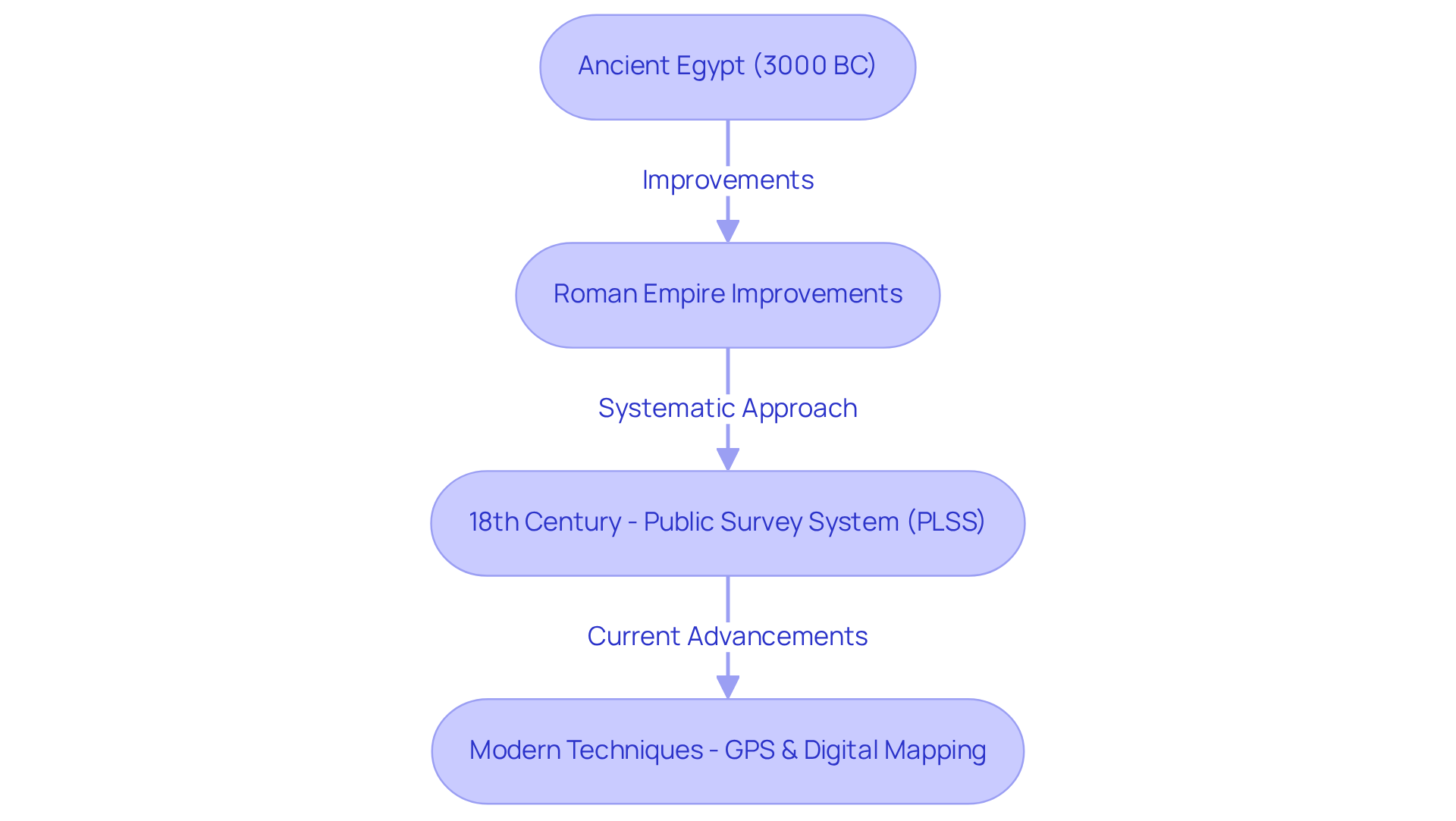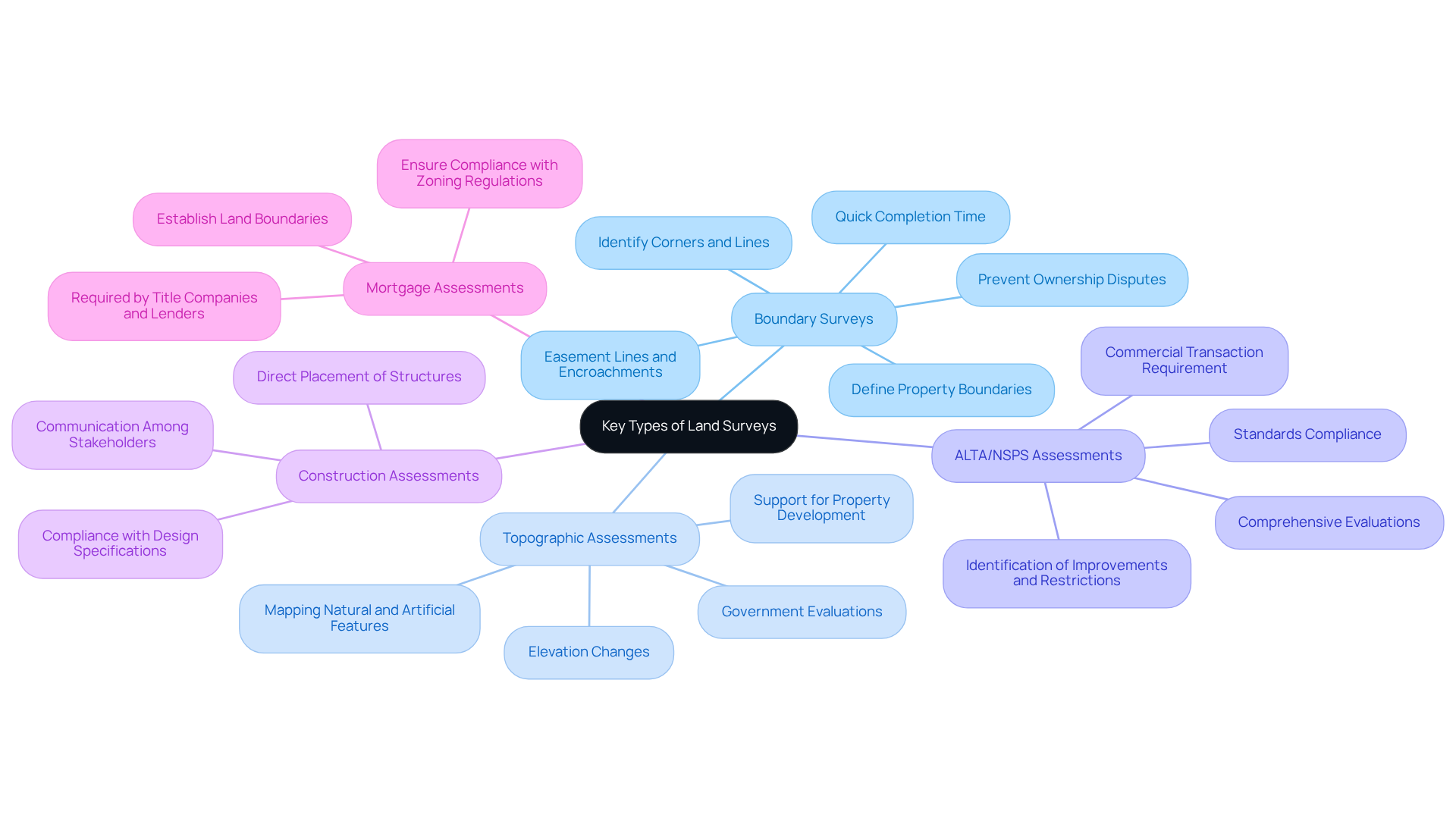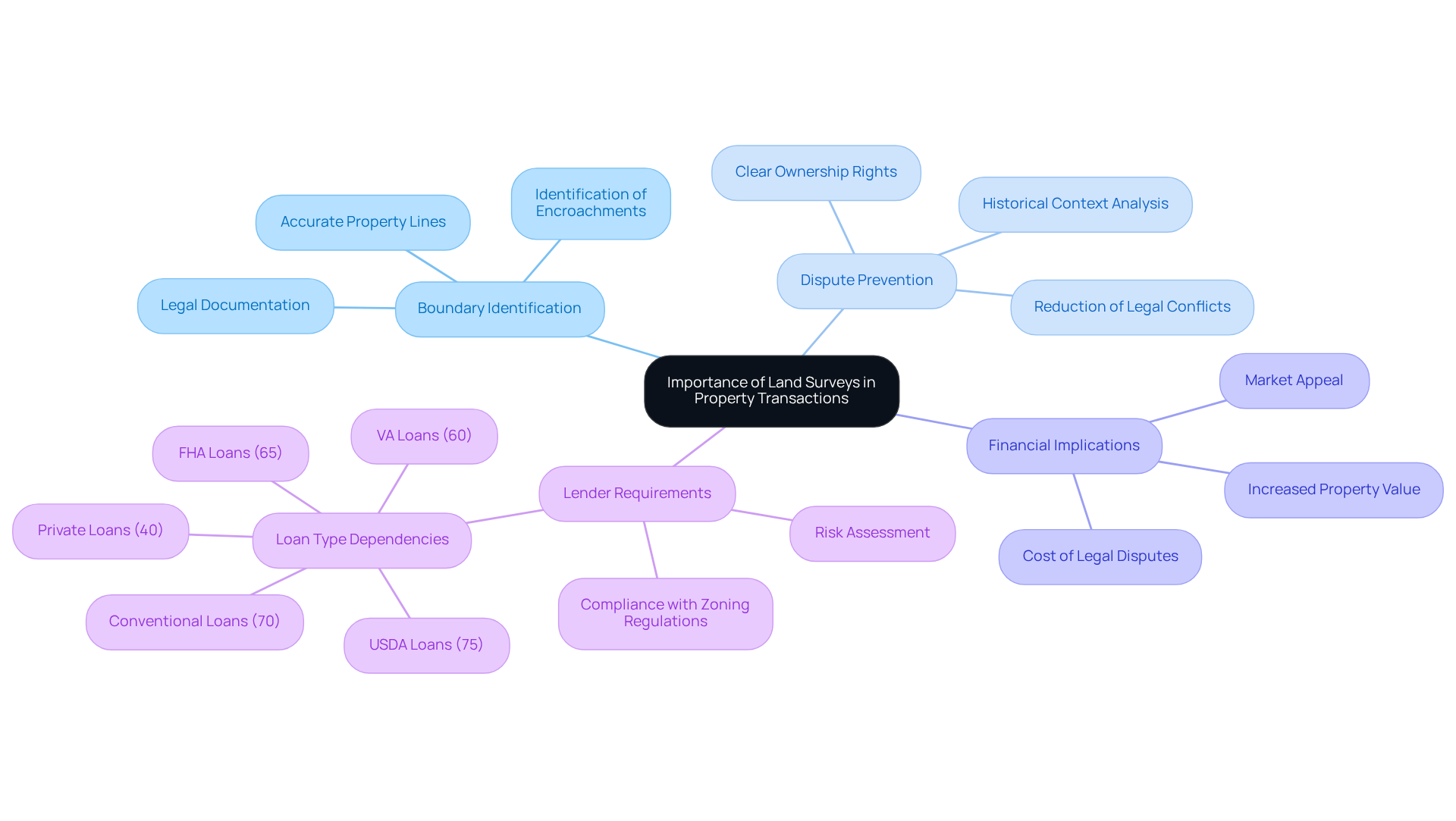Overview
The significance of land surveys in real estate is paramount, as they play a crucial role in accurately defining property boundaries and preventing disputes. This is essential for safeguarding ownership rights and facilitating seamless transactions. Notably, approximately 80% of real estate disputes arise from ambiguous boundaries. Furthermore, this article illustrates how professional assessments can mitigate legal complications and enhance market appeal by ensuring that all property features are meticulously documented and legally recognized.
Introduction
The intricate world of real estate often hinges on one critical element: clarity. Land surveys serve as the backbone of property transactions, providing essential insights into boundaries, easements, and encroachments that can make or break a deal. As buyers and sellers navigate the complexities of ownership, understanding the importance of these assessments becomes paramount. Furthermore, with nearly 80% of real estate disputes stemming from unclear boundaries, the stakes are high.
How can a simple survey transform potential conflicts into seamless transactions? What role does historical evolution play in shaping today’s surveying practices? The answers to these questions are vital for anyone involved in property transactions.
Define Land Surveys and Their Role in Real Estate
Property assessments are expert evaluations that determine the limits, measurements, and features of a plot of ground. These assessments illustrate the in real estate, as they provide accurate details about land boundaries, easements, and encroachments. This clarity is essential for buyers, sellers, and real estate professionals, ensuring that transactions are conducted fairly and legally. By precisely outlining ownership limits, assessments significantly reduce the likelihood of conflicts and misinterpretations among neighbors, thus promoting more seamless real estate dealings.
Statistics indicate that approximately 80% of real estate disputes arise from ambiguous boundaries, highlighting the importance of land surveys in real estate for conducting thorough assessments. A notable case study on unforeseen land encroachments illustrates how a developer avoided costly legal issues by identifying boundary inconsistencies through a land assessment, allowing them to resolve potential disputes before they escalated. Furthermore, professional insights reveal that engaging a licensed assessor, such as Keith Maxwell, enhances the precision of the assessment and lends legal significance to the results, which is vital in real estate transactions. Maxwell asserts, "The assessment establishes a permanent record that outlines the property boundaries and is occasionally mandated by local or state regulations prior to the issuance of any building permits."
In summary, the importance of land surveys in real estate is underscored by property assessments, which serve a critical function in ensuring transparency and security in transactions, particularly in light of technological advancements that enhance their accuracy and effectiveness.

Trace the Historical Development of Land Surveys
Land surveying boasts a rich history, tracing back to ancient civilizations, with the earliest documented practices emerging in Egypt around 3000 BC. These initial surveys were pivotal for establishing property ownership and taxation systems.
As societies evolved, surveying methods underwent significant improvements, particularly during the Roman Empire, where advanced instruments such as the groma and chorobates enabled precise terrain measurements.
In the United States, the establishment of the Public Survey System (PLSS) in the 18th century marked a crucial moment, providing a systematic approach for property division and description that laid the foundation for contemporary surveying techniques.
Today, terrain evaluations leverage like GPS and digital mapping, enhancing both precision and efficiency in asset assessments. The integration of these modern techniques illustrates a continuous evolution within the field, underscoring the importance of land surveys in real estate as an essential component of due diligence.

Identify Key Types and Characteristics of Land Surveys
Land surveys play a crucial role in real estate, with several key types serving distinct purposes:
- Boundary Surveys: These surveys are essential for defining the exact boundaries of a property. They identify corners and lines based on legal descriptions, ensuring clarity in ownership and preventing disputes. Boundary assessments often encompass easement lines and encroachments, which are vital for realtors and homeowners alike. Statistics indicate that perimeter assessments can typically be completed within a few days, depending on field and record investigation, rendering them a prompt resource for real estate transactions. As noted, "Each corner marked by a surveyor touches the future," emphasizing the lasting impact of accurate boundary definitions.
- Topographic Assessments: These assessments provide a comprehensive mapping of both natural and artificial features on a site, including elevation changes, vegetation, and existing structures. They are particularly influential in property development, as engineers and architects rely on topographic data to design improvements or developments effectively. Furthermore, topographical assessments may be necessary for government entities to evaluate site suitability for construction projects, underscoring their significance in the due diligence process.
- ALTA/NSPS Assessments: These comprehensive evaluations adhere to specific standards set by the American Land Title Association and the National Society of Professional Surveyors. They are often mandated for commercial transactions, ensuring thoroughness in identifying improvements, right-of-way, easements, and restrictions on land. The preparation of ALTA assessments can take weeks or even months, reflecting their complexity and the essential information they provide.
- Construction Assessments: These evaluations are critical during the construction phase, directing the placement of structures and enhancements on a property. They ensure compliance with design specifications and help avoid costly mistakes. Building assessments necessitate clear communication among engineers, assessors, and contractors to ensure that projects progress seamlessly.
- Mortgage Assessments: These assessments establish land boundaries and building locations, frequently needed by title companies and lenders. They guarantee that no structures intrude on the land and that all are adhered to, emphasizing the significance of comprehensive due diligence in real estate dealings.
Every category of assessment provides vital data that aids informed decision-making in real estate dealings, underscoring the importance of land surveys in real estate and reinforcing the significance of thorough due diligence in asset ownership.

Examine the Practical Importance of Land Surveys in Property Transactions
The importance of land surveys in real estate is pivotal in transactions for various reasons, primarily ensuring accurate boundary identification, which is crucial for validating ownership rights and preventing conflicts. For instance, properties sold without recent assessments experience a 25% higher incidence of disputes over a decade compared to those evaluated prior to acquisition. Such disputes can lead to significant financial losses and costly legal challenges, emphasizing the to conduct thorough assessments.
A boundary assessment can uncover encroachments from neighboring landowners, safeguarding buyers from potential legal complications. Furthermore, lenders often require assessments to assess risk and ensure compliance with zoning regulations, with traditional loans having approximately a 70% likelihood of necessitating an evaluation.
As Jorge Vazquez articulates, "Surveys can avert future conflicts and provide reassurance by ensuring that all physical features of the site are accurately documented and legally recognized." Assessments, by delineating real estate boundaries and characteristics, underscore the importance of land surveys in real estate, facilitating smoother transactions and ultimately protecting the interests of all parties involved.
Without a proper assessment, buyers face the risk of unforeseen challenges, including costly legal disputes and substantial financial setbacks. Accurate land boundaries not only define ownership rights but also enhance market appeal, as buyers are more inclined to invest in properties with clearly defined limits. Additionally, engaging licensed surveyors guarantees expertise and legal acknowledgment of the survey, further alleviating risks associated with property transactions.

Conclusion
Understanding the significance of land surveys in real estate is paramount for ensuring clarity, legality, and security in property transactions. These assessments not only delineate ownership boundaries but also mitigate potential disputes arising from ambiguous property lines. By delivering precise measurements and insights into land characteristics, land surveys serve as foundational tools that empower buyers, sellers, and real estate professionals to navigate the complexities of property dealings effectively.
Key points highlighted throughout the article include:
- The historical evolution of land surveying practices
- The various types of surveys
- Their critical roles in real estate transactions
From boundary surveys that establish clear property lines to topographic assessments that inform development plans, each type of survey contributes significantly to informed decision-making and risk management. The statistics presented underscore the tangible benefits of conducting thorough assessments, such as reducing the likelihood of disputes and enhancing property value.
Ultimately, the importance of land surveys in real estate cannot be overstated. They are indispensable in fostering transparent and secure transactions, protecting the interests of all parties involved. As the real estate landscape continues to evolve, embracing modern surveying technologies and practices will further enhance the accuracy and reliability of these assessments. Engaging licensed professionals for land surveys is not merely a regulatory requirement; it is a proactive step toward safeguarding investments and ensuring that property ownership is clearly defined and recognized.
Frequently Asked Questions
What are land surveys and their purpose in real estate?
Land surveys are expert evaluations that determine the limits, measurements, and features of a plot of land. They provide accurate details about land boundaries, easements, and encroachments, which are essential for buyers, sellers, and real estate professionals to ensure fair and legal transactions.
Why are land surveys important for real estate transactions?
Land surveys are important because they clarify ownership limits, significantly reducing the likelihood of conflicts and misinterpretations among neighbors. This clarity promotes smoother real estate dealings and helps prevent disputes related to ambiguous boundaries.
What percentage of real estate disputes arise from boundary issues?
Approximately 80% of real estate disputes arise from ambiguous boundaries, highlighting the critical role of land surveys in preventing such issues.
Can you provide an example of how land surveys can prevent disputes?
A case study showed that a developer avoided costly legal issues by identifying boundary inconsistencies through a land assessment. This allowed them to resolve potential disputes before they escalated.
How does engaging a licensed assessor impact the accuracy of land surveys?
Engaging a licensed assessor, such as Keith Maxwell, enhances the precision of the assessment and lends legal significance to the results, which is vital in real estate transactions.
What does Keith Maxwell say about the legal significance of land assessments?
Keith Maxwell states that 'the assessment establishes a permanent record that outlines the property boundaries and is occasionally mandated by local or state regulations prior to the issuance of any building permits.'
How do technological advancements affect land surveys?
Technological advancements enhance the accuracy and effectiveness of land surveys, making them even more critical for ensuring transparency and security in real estate transactions.




